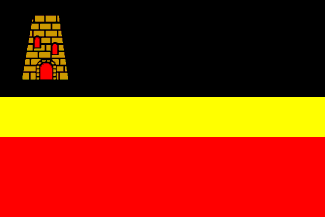
by Blas Delgado Ortiz, 13 December 2004

Last modified: 2014-05-29 by zoltán horváth
Keywords: puerto rico | guayama | mill tower | sugar cane | sugar mill |
Links: FOTW homepage |
search |
disclaimer and copyright |
write us |
mirrors

by Blas Delgado Ortiz, 13 December 2004
See also:
This city of 43,583 inhabitants was founded on January 29,
1736. The design in the canton of its flag is the old Torre de
Molino [Mill Tower], known as the Molino de Vives. The black
stands for the Black and African race of Puerto Rico . The yellow
represents the economic benefit gained from sugar cane in PR. The
red symbolizes the blood shed by Indian slaves in their fight
against foreign invaders.
Thanh-Tâm Le, 27 January 1999
Please note that "Franja Negra - La raza africana o negra
de Puerto Rico" , means that the top stripe is black,
not blue as it seems on pueblos-de-puertorico.com (dufunct) image
Nicolas Rucks , 31 January 2000
By comparison with the coat of arms of Antigua
& Barbuda and the explanation given for instance in
Tallocci, I understand this 'Mill Tower' is the part of an
ancient sugar mill, probably used in Guyama flag to highlighy
sugar cane and sugar production in the area.
Ivan Sache , 31 January 2000
Guayama - The flag is arranged with three (unequal) stripes of
different color. At the left (hoist) extreme side of the upper
stripe is the old Mill Tower, which is known today as Vives Mill.
Each color means the following:
· Black stripe - Puerto Rico's Black or African race.
· Yellow stripe - the economic profit of Puerto Rico attained
from the sugar cane industry.
· Red stripe - the blood shed by the Indian slaves in their
fights against foreign invasions.
Blas Delgado, 14 April 2001
lexjuris site Flag

by Thanh-Tâm Le , 27 January 1999
Pueblos-de-puertorico.com site (dufunct) Flag
gm04.gif)
by Nelson L. Román, 13 December 2004
The new Coat of Arms of the city of Guayama, Puerto Rico. The
only change indeed is the five towered mural crown over the
shield, signifying the new status of "city" bestowed
recently upon the villa, on August 2004.
Blas Delgado Ortiz, 13 December 2004
Previous Coat of Arms
gm.gif)
by Nelson L. Román, 4 July 2004